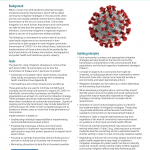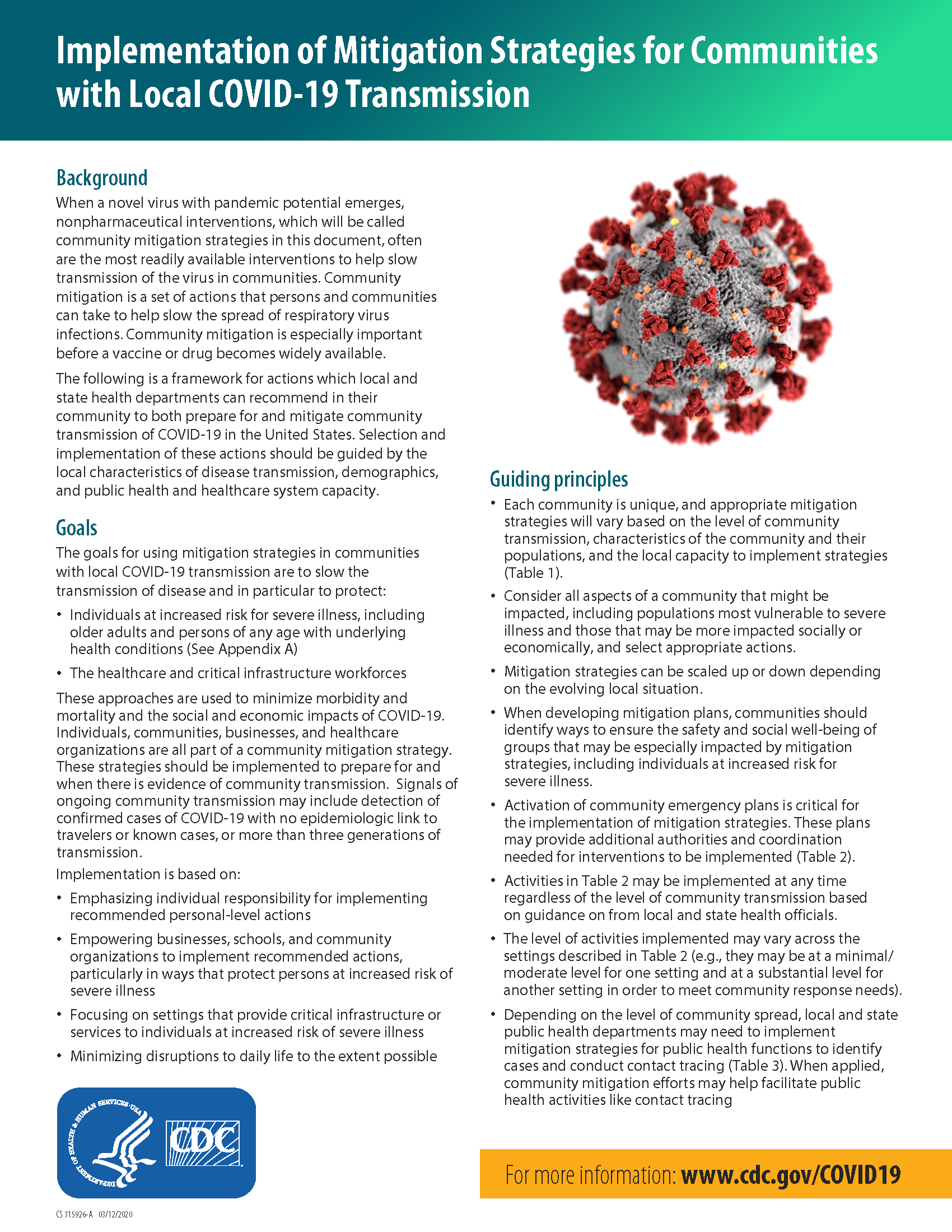Good day, dear patients!
A few of you have submitted questions about the recent statements in azithromycin and Plaquenil (hydroxychloroquine).
Please note that some of what is stated below is my personal opinion and not formal guidance. I have included source links where applicable and, as always, encourage you to continue to use the CDC and VDH guidance to help in your planning.
To begin, the CDC has posted an update on treatment options for COVID19, the disease caused by the 2019 novel Coronavirus, also known as SARS-CoV-2. Terminology can be confusing!
I acknowledge that even some of the medical community may have

with Local COVID-19 Transmission
underestimated the potential for this virus to wreak havoc as it has. In an attempt to find a balance between appropriate precautions and offering reassurance, new statements like, “it’s just like the flu,” were made by many. That statement concerned me because it showed how quickly history was forgotten. The flu of 1918 devastated the world, if you may recall. ***
There was an interesting editorial from 2018 regarding lessons learned. We have certainly made a great deal of progress. Still, these words were kind of chilling because many in the industry already knew this to be true: “Despite improvements since 1918, governments and health care systems remain inadequately prepared for the impact of a 1918-like severe influenza pandemic.”
That said, I strongly encourage people, whether you’re “at risk” or not, to embrace the recommendations for social distancing and aggressive handwashing. We are now starting to see what most HCW have said all along: we are ALL at risk! Even if you are young, you might still become very ill. An ER colleague of mine told me of a 36-year-old being placed on life support despite social smoking being his only risk factor. This is not meant to frighten you, but rather to remember that anyone can be the exception to the rule.
The District of Columbia reported cases in children over the weekend and several new cases under the age of 60. The DMV region is seeing increasing case numbers, which we partially expect because there are more testing sites. However, we also see more deaths.
Latest coronavirus test results in DC, Maryland, and Virginia | WTOP
Going back to the original question:
The results of the French study on azithromycin and hydroxychloroquine are publicly accessible here.
It’s certainly encouraging. My concerns lie in the fact that:
1. Much of the general population may not realize this is for treatment only. From the original French study, which was, to me, well designed, “we, therefore, recommend that COVID-19 patients be treated with hydroxychloroquine and azithromycin to cure their infection and to limit the transmission of the virus to other people to curb the spread of COVID-19 in the world. Further works are also warranted to determine if these compounds could be useful as chemoprophylaxis to prevent the transmission of the virus.”
There are chemoprophylaxis trials submitted for review – see clinicaltrials.gov (tables are listed below) or the shortlist at the end of this document. Still, some of these are not even recruiting participants yet and would not start till May, probably. The studies done to date in other countries are relatively small.
2. I don’t expect the general population to know the difference between chloroquine and hydroxychloroquine. They are not the same. Both possess a lot of side effects. The first part of the Hippocratic oath is to first, do no harm—these drugs, especially when mixed w azithromycin, put some people at risk for fatal arrhythmias. Caution is advised, and thus these drugs shouldn’t be used indiscriminately. But yes, they can be used safely for long term use, so I was glad to see the drugs being studied are ones with which we are already familiar. The danger in that is what I heard happening in other nations. People were trying to self-administer to the point the Nigerian govt had to issue public service announcements about it.
Plaquenil has a better safety profile than chloroquine, but we have already been seeing shortages. That becomes a bigger issue when understanding that this is a maintenance drug for patients with lupus. We don’t write Plaquenil for “just bad arthritis.” Lupus is an autoimmune disorder that already puts those patients at risk for infection. If they do not have access to their maintenance drug, they will be more likely to flare.
If you think getting a mask is difficult, imagine what providers are going through with these drugs, and this is just the beginning!
Speaking of masks… don’t forget that hospitals are already low or even out of masks, and while there has been encouragement by many to simply reuse the masks, most of my hospital colleagues have said their systems are not permitting reuse of masks because it increases the risk for self-contamination, and also surgical masks can lose their efficacy if they are wet or soiled with debris.***
I saw several studies from the past few years investigating self-contamination when the public wears a mask and also when masks are reused. That said, PLEASE be careful and follow the CDC guidance if you are using/reusing a mask. And please consider donating your supplies to a hospital if you have a surplus. Ideally, people should be socially distancing and not requiring masks as much.
An excerpt on the appropriate use of masks:
• Replace the face mask between each patient/situation/procedure or after 2–6 h if you are with the same patient or when it is wet on the inside. Avoid changing the mask if this can cause more contamination and risk, for instance, during surgery. Surgical masks are usually not changed during surgery.
• Never go with a face mask under the chin or around your neck! It is usually heavily contaminated by mouth and nose secretion after use and by splatter from the patient.
Protection of Upper Respiratory Tract, Mouth and Eyes | SpringerLink
Finally, please understand that, as of now, I would not be treating COVID19 outside a hospital setting as we simply do not have the resources to do this safely, specifically testing materials and isolation materials. We also don’t have negative pressure to isolate a COVID19 patient from the rest of the patients. Like the rest of the population, I await further guidance on the next steps in the outbreak.
This is certainly an exciting time in medicine! We are cautiously optimistic about evolving treatment options. Please note that, as is the case with many things, prevention is the best approach. While we may debate about whether action should have been taken sooner or whether it’s already too restrictive, I want to encourage you all to work together as a community to help limit the spread of this illness by using common sense guidance that we have already heard: Wash your hands, don’t touch your face, and socially distance. We are finding a new mantra; it seems!
Please continue to stay safe and healthy!
With warm wishes from all of us here at EHPVA,
Dr. Kanal
*** These are the deeper cuts – the articles for those exceptionally curious folks out there who are interested in the policy side.
There was an interesting editorial from 2018 regarding lessons learned. We have certainly made a great deal of progress. Still, these words were kind of chilling because many in the industry already knew this to be true: “Despite improvements since 1918, governments and health care systems remain inadequately prepared for the impact of a 1918-like severe influenza pandemic. ”
The supply shortage isn’t a new issue, as journals have previously commented on the inappropriate use of masks and public perception potential leading to shortages. This Article is from 2016.
There was interim CDC guidance on the reuse of masks, but this is only for crises, and we don’t know what the risks are: Strategies for Optimizing the Supply of Facemasks: COVID-19 | CDC
Sincerely,
Monica Kanal, DO, MPH
Encompass Health Partners, PLLC
571-358-9236
Click Here for CDC Information on COVID-19
Click Here for VDH Information on COVID-19
Click Here for Coronavirus.gov
Missed an update? Click Here to visit our ongoing Coronavirus updates page.

